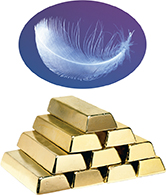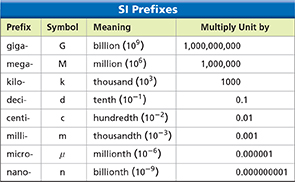Another quantity that requires a derived unit is density. Density is the ratio of an object's mass to its volume.
To derive the SI unit for density, you can divide the base unit for mass by the derived unit for volume. Dividing kilograms by cubic meters yields the SI unit for density, kilograms per cubic meter (kg/m3).
What is the SI derived unit for density?
Metric Prefixes
The metric unit for a given quantity is not always a convenient one to use. For example, the time it takes for a computer hard drive to read or write data—also known as the seek time—is in the range of thousandths of a second. A typical seek time might be 0.009 second. This can be written in a more compact way by using a metric prefix. A metric prefix indicates how many times a unit should be multiplied or divided by 10. Figure 15 shows some common metric prefixes. Using the prefix milli- (m), you can write 0.009 second as 9 milliseconds, or 9 ms.
Note that dividing by 1000 is the same as multiplying by 0.001.
Metric prefixes can also make a unit larger. For example, a distance of 12,000 meters can also be written as 12 kilometers.
Metric prefixes turn up in non-metric units as well. If you have used a digital camera, you may know that a megapixel is 1,000,000 pixels. A kiloton is a unit of explosive force equal to 1,000 tons of TNT.
Figure 16 A bar of gold has more mass per unit volume than a feather. Inferring Which takes up more space—one kilogram of gold or one kilogram of feathers?







